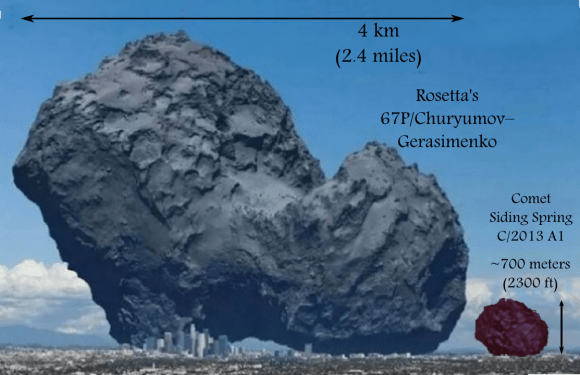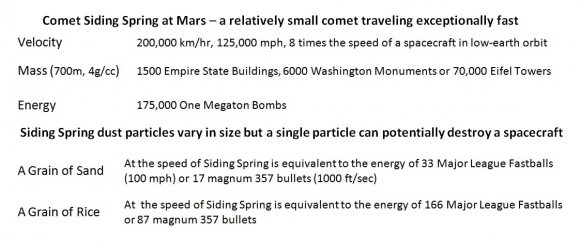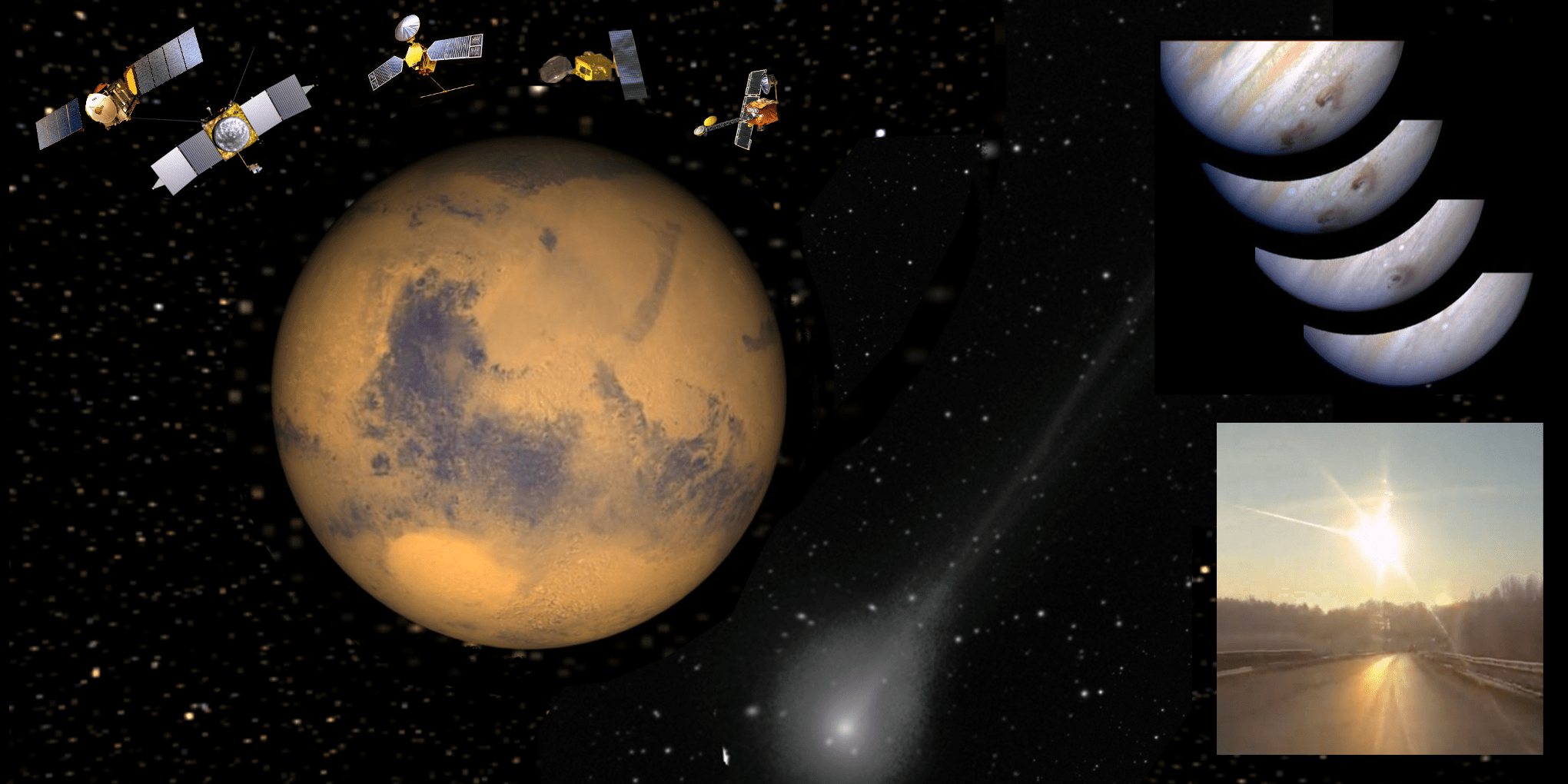It was 20 years ago this past July when images of Jupiter being pummeled by a comet caught the world’s attention. Comet Shoemaker-Levy 9 had flown too close to Jupiter. It was captured by the giant planet’s gravity and torn into a string of beads. One by one the comet fragments impacted Jupiter — leaving blemishes on its atmosphere, each several times larger than Earth in size.
Until that event, no one had seen a comet impact a planet. Now, Mars will see a very close passage of the comet Siding Spring on October 19th. When the comet was first discovered, astronomers quickly realized that it was heading straight at Mars. In fact, it appeared it was going to be a bulls-eye hit — except for the margin of error in calculating a comet’s trajectory from 1 billion kilometers (620 million miles, 7 AU) away.
It took several months of analysis for a cataclysmic impact on Mars to be ruled out. So now today, Mars faces just a cosmic close shave. But this comet packs enough energy that an impact would have globally altered Mars’ surface and atmosphere.
So what should we Earthlings gather from this and other events like it? Are we next? Why or why not should we be prepared for impacts from these mile wide objects?
For one, ask any dinosaur and you will have your answer.

One can say that Mars was spared as were the five orbiting spacecraft from India (Mars Orbiter Mission), the European Union (Mars Express) and the United States (MOD, MRO, MAVEN). We have Scottish-Australian astronomer Robert McNaught to thank for discovering the comet on January 3, 2013, using the half meter (20 inch) Uppsala Southern Schmidt Telescope at Siding Spring, Australia.
Initially the margin of error in the trajectory was large, but a series of observations gradually reduced the error. By late summer 2014, Mars was in the clear and astronomers could confidently say the comet would pass close but not impact. Furthermore, as observations accumulated — including estimates of the outpouring of gases and dust — comet Siding Spring shrunk in size, i.e. the estimates of potentially tens of kilometers were down to now 700 meters (4/10th of a mile) in diameter. Estimates of the gas and dust production are low and the size of the tail and coma — the spherical gas cloud surrounding the solid body — are small and only the outer edge of both will interact with Mars’ atmosphere.

Yet, this is a close call for Mars. We could not rule out a collision for over six months. While this comet is small, it is moving relative to Mars at a speed of 200,000 kilometers/hour (125,000 mph, 56 km/sec). This small body packs a wallop. From high school science or intro college Physics, many of us know that the kinetic energy of an object increases by the square of the velocity. Double the velocity and the energy of the object goes up by 4, increase by 3 – energy increases by 9.
So the close shave for Mars is yet another wake up call for the “intelligent” space faring beings of the planet Earth. A wake up call because the close passage of a comet could have just as easily involved Earth. Astronomers would have warned the world of a comet heading straight for us, one that could wipe out 70% of all life as happened 65 million years ago to the dinosaurs. Replace dinosaur with humans and you have the full picture.
Time would have been of the essence. The space faring nations of the world — those of the EU, and Russia, the USA, Japan and others — would have gathered and attempted to conceive some spacecrafts with likely nuclear weapons that could be built and launched within a few months. Probably several vehicles with weapons would be launched at once, leaving Earth as soon as possible. Intercepting a comet or asteroid further out would give the impulse from the explosions more time to push the incoming body away from the Earth.
There is no way that humanity could sit on their collective hands and wait for astronomers to observe and measure for months until they could claim that it would just be a close call for Earth. We could imagine the panic it would cause. Recall the scenes from Carl Sagan’s movie Contact with people of every persuasion expressing at 120 decibels their hopes and fears. Even a small comet or asteroid, only a half kilometer – a third of a mile in diameter would be a cataclysmic event for Mars or Earth.
But yet, in the time that has since transpired from discovery of the comet Siding Spring (1/3/2013), the Chelyabinsk asteroid (~20 m/65 ft) exploded in an air burst that injured 1500 people in Russia. The telescope that discovered Comet Siding Spring was decommissioned in late 2013 and the Southern Near-Earth Object Survey was shutdown. This has left the southern skies without a dedicated telescope for finding near-Earth asteroids. And proposals such as the Sentinel project by the B612 Foundation remain underfunded.
We know of the dangers from small celestial bodies such as comets or asteroids. Government organizations in the United States and groups at the United Nations are discussing plans. There is plenty of time to find and protect the Earth but not necessarily time to waste.
Previous U.T. Siding Spring stories:
“What Comets, Parking Lots and Charcoal Have in Common“, Bob King, Sept 5, 2014
“MAVEN Mars Orbiter Ideally Poised to Uniquely Map Comet Siding Spring Composition
– Exclusive Interview with Principal Investigator Bruce Jakosky”, Ken Kremer“, Sept 5, 2014
“NASA Preps for Nail-biting Comet Flyby of Mars“, BoB King, July 26,2014


Curious why a fly by 82,000 miles from Mars by an object 700 meters across is considered by scientist “a close call”? Despite its high speed, hard to fathom how this “close encounter” could have any planetary-wide affect.
The nominal orbit never showed an impact solution (bulls-eye hit) and we have known that it would not impact since summer 2013.
How far from Mars is it supposed to pass?
This comet is behaving below predictions right now, but only needs a passing CME to brighten things up a bit! I’d like to see a CME cause enough explosive out-gassing to change it’s orbit so that it DOES smack into Mars after all! A CME or collision with an asteroid?